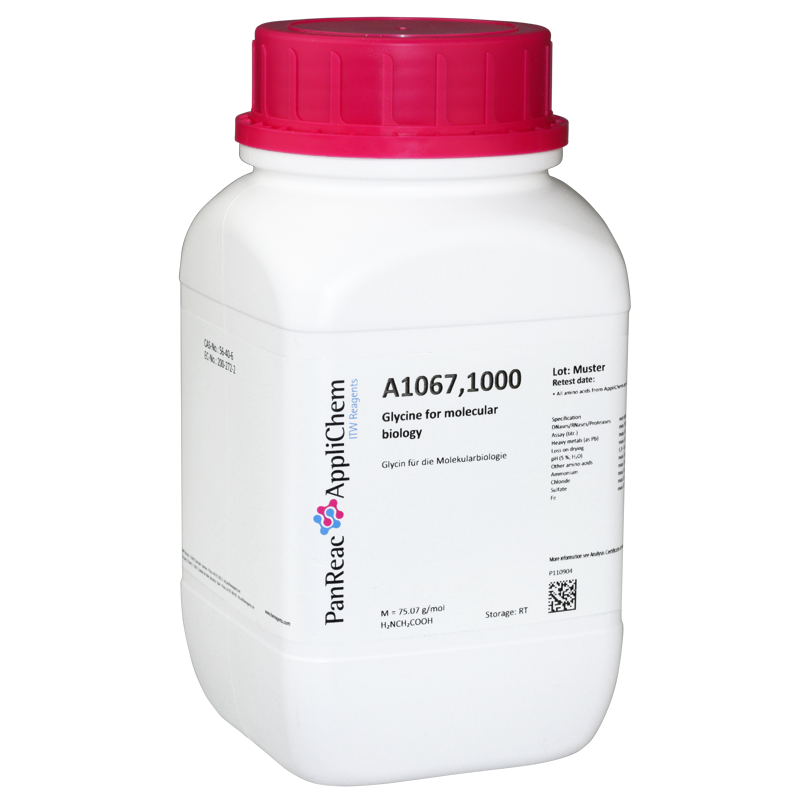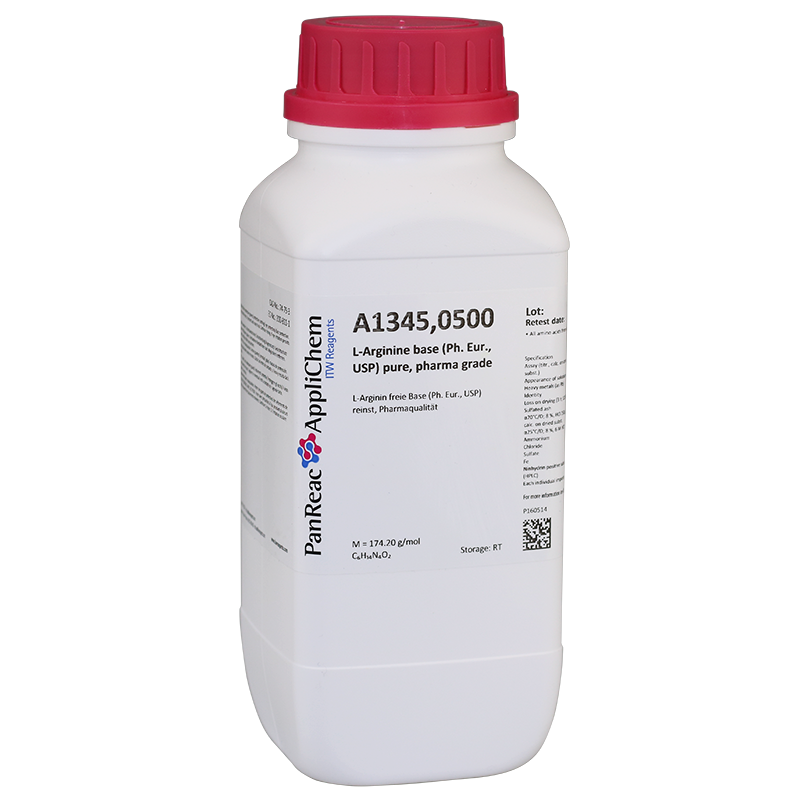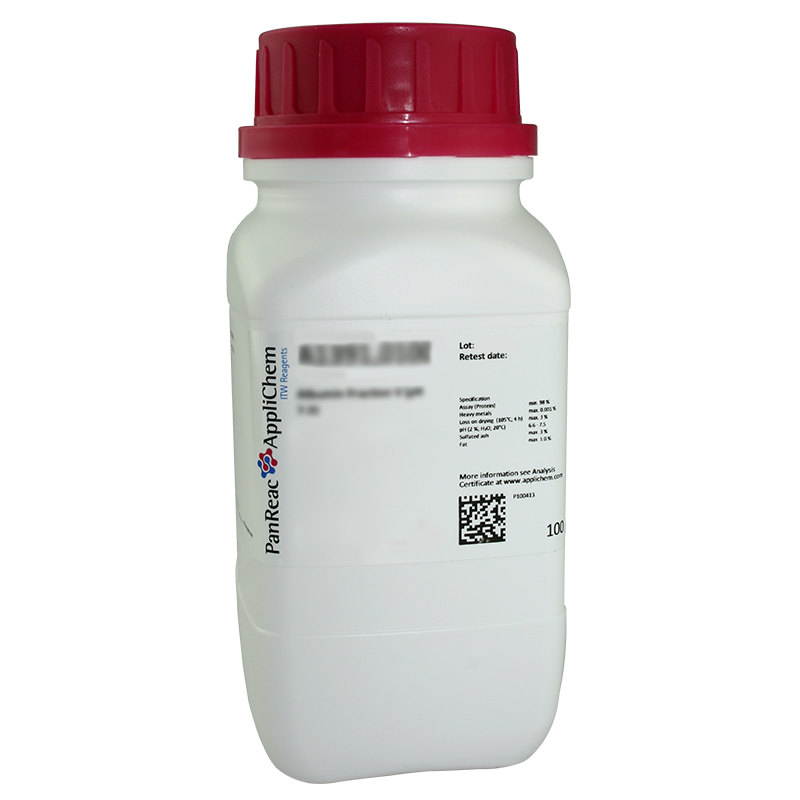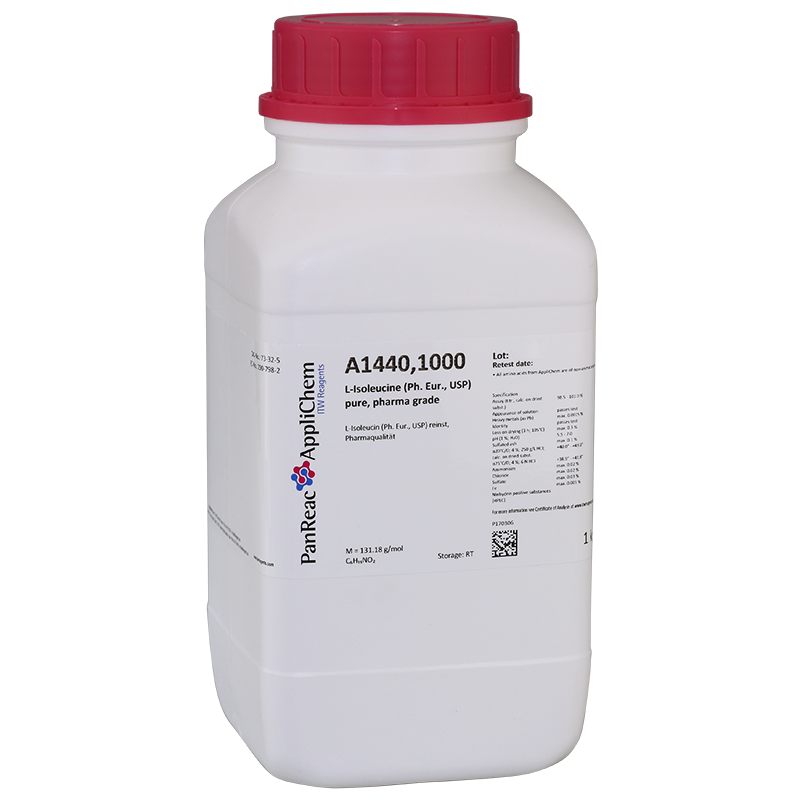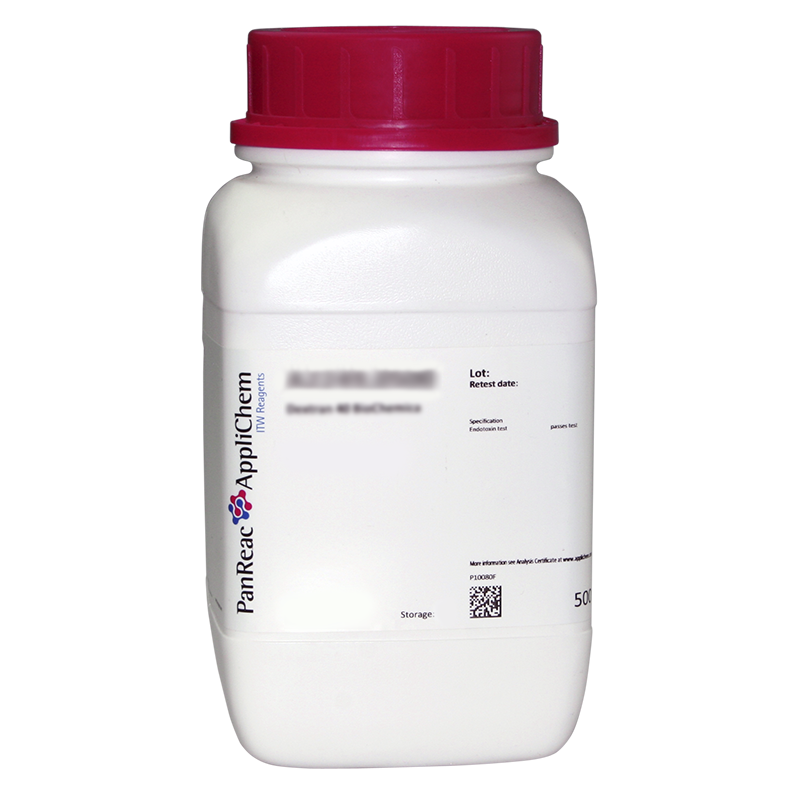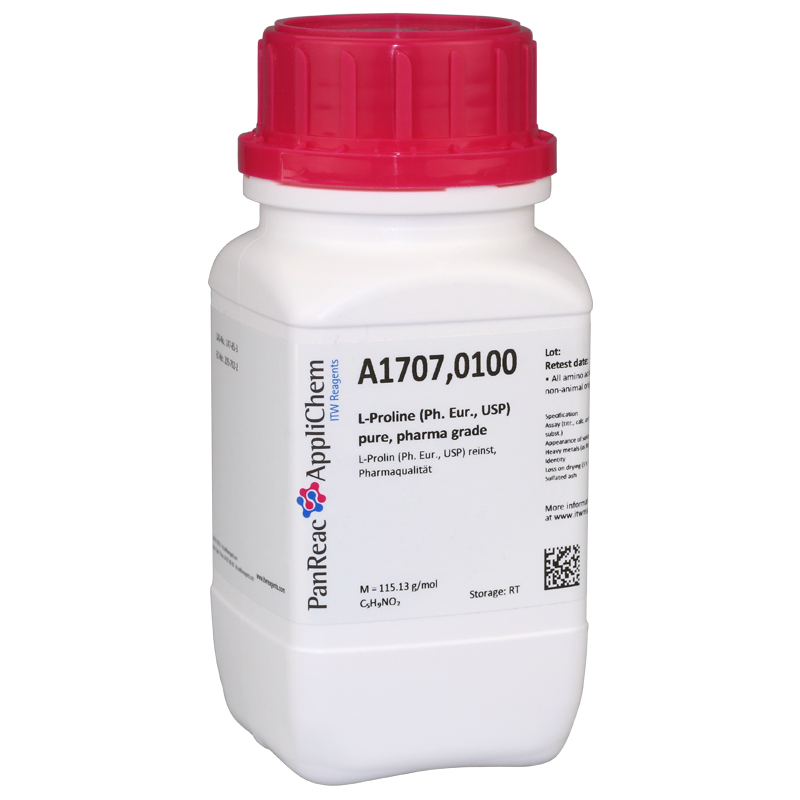Featured products
59 products available
- Glycine for molecular biology A1067,1000 · 56-40-6
- Glycine for molecular biology A1067,5000 · 56-40-6
- L-Alanine (Ph. Eur., USP) pure, pharma grade A1688,0100 · 56-41-7
- L-Arginine base (Ph. Eur., USP) pure, pharma grade A1345,9010 · 74-79-3
- L-Arginine base (Ph. Eur., USP) pure, pharma grade A1345,1000 · 74-79-3
- L-Arginine base (Ph. Eur., USP) pure, pharma grade A1345,0500 · 74-79-3
- L-Arginine Hydrochloride (Ph. Eur., USP) pure, pharma gradeA1700,9015 · 1119-34-2
- L-Arginine Hydrochloride (Ph. Eur., USP) pure, pharma gradeA1700,1000 · 1119-34-2
- L-Arginine Hydrochloride BioChemica A3709,1000 · 1119-34-2
- L-Asparagin anhydrous (USP-NF) pure, pharma grade 147755.0914 · 70-47-3
- L-Asparagine 1-hydrate (Ph.Eur.) pure, pharma gradeA1668,1000 · 5794-13-8
- L-Asparagine 1-hydrate (Ph.Eur.) pure, pharma gradeA1668,9025 · 5794-13-8
- L-Asparagine 1-hydrate BioChemica A3721,1000 · 5794-13-8
- L-Asparagine 1-hydrate BioChemica A3721,0100 · 5794-13-8
- L-Aspartic Acid (Ph. Eur., USP) pure, pharma grade A1701,1000 · 56-84-8
Amino Acids (AA)
Introduction
Amino acids are chemical, organic compounds that simultaneously contain a nitrogen-bearing amino group (-NH2) and a carbon and oxygen-containing carboxylic acid group (-COOH). Chemically, they can be distinguished according to the position of their amino group in relation to the carboxyl group - if the amino group on the Cα atom is immediately adjacent to the terminal carboxy group, this is called α-terminal and is referred to as α-amino acids. In common usage, the so-called α-amino acids are usually meant. They are biomolecules that occur in all living organisms. Proteins are made of them. Amino acids are therefore the building blocks of life. They are universally contained in the genetic code.
In humans, 21 proteinogenic amino acids are known. Proteinogenic amino acids are amino acids that are used in the construction of proteins. In addition to the 20 canonical (standard) amino acids, there is also selenocysteine here. These are α-amino acids in each case.
In bacteria, on the other hand, pyrolysine can occur as the 21st amino acid. The human organism can synthesise 12 of the 20 amino acids either itself or through intestinal microbes. Eight amino acids must be taken in through food. They are called essential. The eight essential amino acids are valine, methionine, leucine, isoleucine, phenylalanine, tryptophan, threonine and lysine.
α-Amino acids:
The amino group of α-amino acids is located at the second carbon atom, including the carboxy carbon atom. The counting always starts with the carboxy-carbon. The IUPAC designation is therefore 2-aminocarboxylic acids. The simplest representative of the α-amino acids is the proteinogenic amino acid glycine. All proteinogenic amino acids are α-amino acids. The term amino acids often refers to a specific group of α-amino acids that consists mainly of L-α-amino acids: the proteinogenic amino acids. These are the building blocks of all proteins of all life on earth and, along with nucleic acids are the basic building blocks of life.
Selected α-amino acids are the natural building blocks of proteins. They are linked together to form chains by the carboxy group of one amino acid forming a peptide bond with the amino group of the next. The amino acids chained together in this way to form a polymer differ in their side chains and together determine the form with which the polypeptide then unfolds in the aqueous milieu to form the native protein. This biosynthesis of proteins takes place in all cells at the ribosomes according to genetic information, which is available in the form of mRNA.
The base sequence of the mRNA encodes the amino acid sequence in triplets, whereby one base triplet each represents a codon that stands for a specific proteinogenic amino acid. The amino acids hereby indicated as building blocks for the formation of proteins in a specific sequence form the proteins. After translation, as the process of translating mRNA into amino acid sequence is called, the side chains of some amino acids incorporated in the protein can still be modified.
However, the spectrum of amino acids goes far beyond these twenty proteinogenic ones. So far, more than 400 non-proteinogenic naturally occurring amino acids are known that have biological functions. The comparatively rare D-amino acids represent a special group. The variety of synthetically produced and theoretically possible amino acids is even greater.
Some amino acids play a special role as neurotransmitters, as do various degradation products of amino acids; biogenic amines not only occur as messengers in the nervous system, but also unfold diverse physiological effects in the organism as hormones and tissue mediators.
The simplest amino acid, glycine, has been found not only on Earth but also on comets, meteorites and in gas clouds in interstellar space.
Chemical and physical properties
The proteinogenic amino acids can be divided into groups according to their residues. One amino acid can appear in different groups at the same time.
Due to the basic amino group and the acidic carboxylic acid group, amino acids are both bases and acids. As solids and in neutral aqueous solutions, amino acids exist as zwitterions, i. e. the amino group is protonated and the carboxy group is deprotonated.
As a zwitterion, the protonated amino group can react as an acid (proton donor) and the carboxylate group can react as a base (proton acceptor). In acidic solutions, amino acids are present as cations and in basic solutions as anions.
The charge of an amino acid molecule depends on the pH of the solution. In the case of a zwitterion with an acidic and a basic group, the total charge of the molecule is zero at neutral pH. In addition, some of the side chains of the amino acids have acidic or basic charged groups. The pH value with a net charge of zero is the isoelectric point (pHI, pI) of an amino acid. The water solubility of an amino acid is lowest at the isoelectric point.
| Amino acid | pk2 | pk1 | Isoelectric point | pk1 | pk2 |
| COOH | COOH | NH2 | NH2 | ||
| Alanine | – | 2,3 | 6,1 | 9,9 | – |
| Arginine | – | 2,81 | 10,76 | 9,09 | 12,5 |
| Aspartic | – | 2,02 | 5,41 | 8,8 | – |
| Aspartic acid | 3,65 | 1,88 | 2,85 | 9,6 | – |
| Cysteine | 8,33 | 1,71 | 5,05 | 10,78 | – |
| Glutamine | – | 2,17 | 5,65 | 9,13 | – |
| Glutamic acid | 4,25 | 2,19 | 3,22 | 9,67 | – |
| Glycine | – | 2,21 | 5,97 | 9,15 | – |
| Histidine | – | 1,78 | 7,47 | 8,97 | 5,97 |
| Isoleucine | – | 2,32 | 5,94 | 9,76 | – |
| Leucine | – | 2,4 | 5,98 | 9,6 | – |
| Lysine | – | 2,2 | 9,59 | 8,9 | 10,28 |
| Methionine | – | 2,28 | 5,74 | 9,21 | – |
| Phenylalanine | – | 2,58 | 5,84 | 9,24 | – |
| Proline | – | 1,99 | 6,3 | 10,6 | – |
| Serine | – | 2,21 | 5,68 | 9,15 | – |
| Threonine | – | 2,1 | 5,6 | 9,12 | – |
| Tryptophan | – | 2,15 | 5,64 | 9,12 | – |
| Tyrosine | 10,07 | 2,2 | 5,66 | 9,11 | – |
| Valine | – | 2,3 | 5,96 | 9,6 | – |
For the acid-base behaviour of proteinogenic amino acids, the behaviour of their side chain (henceforth designated R, for residue) is of particular interest. In proteins, the NH2 and COOH groups cannot be protonated at physiological pH (around pH 7) because of the peptide bond and thus cannot be titrated. Exceptions are the amino and the carboxy terminus of the protein. Therefore, the side chain residue R is decisive for the acid-base behaviour of proteins and peptides.
The behaviour of the side chain R depends on its constitution, i.e. whether the side chain itself can act again as a proton acceptor or as a proton donor. The proteinogenic amino acids are divided according to the functional groups into those with non-polar or polar amino acid side chains and further subdivided into subgroups sorted according to polarity: aliphatic, aromatic, amidated, sulphur-containing, hydroxylated, basic and acidic amino acids.
The side chains of tyrosine and cysteine are relatively acidic compared to the other non-polar side chains, but tend to deprotonate only at unphysiologically high pH values. Proline is a secondary amino acid because the N-terminus forms a five-atom ring with the side chain. Within a protein, the carboxy-terminus of a preceding amino acid binds to the nitrogen of the proline, which cannot be protonated due to the peptide bond already mentioned. Histidine, tyrosine and methionine each occur in two subgroups.
The pK value is the pH value at which the titratable groups are present in equal parts protonated and deprotonated; the titratable group is then present in equal parts in its basic and acidic form (see also: Henderson-Hasselbalch equation).
It is usually customary to speak of the pK instead of the pKS, thus of the pK of the acid. In this sense, however, the pK of lysine should be spoken of as pKB, the pK of the base. For reasons of simplification, however, this notation is generally omitted, since it is also clear from the context of meaning whether the group acts as a base or an acid.
The pK is not a constant, but depends on the temperature, the activity, the ionic strength and the immediate environment of the titratable group and can therefore vary greatly.
If the pH is higher than the pK of a titratable group, the titratable group is in its basic (deprotonated) form. If the pH is lower than the pK of the titratable group, the titratable group is in its acidic (protonated) form:
- For Asp (pK = 3.86) at pH 7: the side chain is almost completely deprotonated.
- For Lys (pK = 10.53) at pH 7: The side chain is almost completely protonated.
The side chains of basic amino acids are single positively charged in their protonated (acidic) form and uncharged in their deprotonated (basic) form. The side chains of acidic amino acids (including cysteine and tyrosine) are uncharged in their protonated (acidic) form and singly negatively charged in their deprotonated (basic) form. Because the behaviour of the side chain is quite different when it is charged or uncharged, the pH plays such an important role in the properties of the side chain.
For example, the titratable side chains influence the solubility behaviour of the corresponding amino acid. In polar solvents, the following applies: charged side chains make the amino acid more soluble, uncharged side chains make the amino acid less soluble.
In proteins, this can lead to certain sections becoming more hydrophilic or more hydrophobic, which makes folding and thus also the activity of enzymes dependent on the pH value. Strongly acidic or basic solutions can therefore denature proteins.
| Amino acid | Side chain | |||||||
| Name | Abb. | Symbol | Van der Waals- Volume | Polarity | Hydrophobicity | Acidity / Alkalinity | Acid constant pks | |
| Alanine | Ala | A | 67 | non-polar | 1,8 | neutral | – | |
| Arginine | Arg | R | 148 | polar | −4,5 | basic (strong) | 12,48 | |
| Aspartic | Asn | N | 96 | polar | −3,5 | neutral | – | |
| Aspartic acid | Asp | D | 91 | polar | −3,5 | acidic | 3,9 | |
| Cysteine | Cys | C | 86 | polar | 2,5 | neutral | 8,18 | |
| Glutamine | Gln | Q | 114 | polar | −3,5 | neutral | – | |
| Glutamic acid | Glu | E | 109 | polar | −3,5 | acidic | 4,07 | |
| Glycine | Gly | G | 48 | non-polar | −0,4 | neutral | – | |
| Histidine | His | H | 118 | polar | −3,2 | basic (weak) | 6,04 | |
| Isoleucine | Ile | I | 124 | nonpolar | 4,5 | neutral | – | |
| Leucine | Leu | L | 124 | nonpolar | 3,8 | neutral | – | |
| Lysine | Lys | K | 135 | polar | −3,9 | basic | 10,54 | |
| Methionine | Met | M | 124 | nonpolar | 1,9 | neutral | – | |
| Phenylalanine | Phe | F | 135 | nonpolar | 2,8 | neutral | – | |
| Proline | Pro | P | 90 | nonpolar | −1,6 | neutral | – | |
| Serine | Ser | S | 73 | polar | −0,8 | neutral | – | |
| Threonine | Thr | T | 93 | polar | −0,7 | neutral | – | |
| Tryptophan | Trp | W | 163 | nonpolar | −0,9 | neutral | – | |
| Tyrosine | Tyr | Y | 141 | polar | −1,3 | neutral | 10,46 | |
| Valine | Val | V | 105 | nonpolar | 4,2 | neutral | – | |
Classification of amino acids into groups
Aliphatic amino acid side chains
- alanine
- glycine
- Isoleucine
- leucine
- methionine
- proline
- valine
Aromatic amino acid side chains
- Phenylalanine
- tryptophan
- tyrosine
Amidated amino acid side chains
- asparagine
- Glutamine
Sulphur-containing amino acid side chains
- cysteine
- methionine
Hydroxylated amino acid side chains
- serine
- threonine
- Tyrosine
Basic amino acid side chains
- Lysine
- arginine
- Histidine
Acidic amino acid side chains
- Aspartic acid (dissociates to aspartate)
- Glutamic acid (dissociates to glutamate)
Canonical amino acids
Codons for 20 of the proteinogenic amino acids are found in the (most commonly used) standard version of the genetic code. These are therefore called standard amino acids or canonical amino acids.
In amino acid sequences, the amino acids are usually indicated with a name abbreviation in the three-letter code or represented in the one-letter code by a symbol
| Aminosäure | Acylgroup | Essential | Ø in Proteins |
||
| Name | Abk. | Symbol | |||
| Alanine | Ala | A | Alanyl- | no | 9,0 % |
| Arginine | Arg | R | Arginyl- | semi | 4,7 % |
| Aspartic | Asn | N | Asparaginyl- | no | 4,4 % |
| Aspartic acid | Asp | D | α-Aspartyl- | no | 5,5 % |
| Cysteine | Cys | C | Cysteinyl- | no * | 2,8 % |
| Glutamine | Gln | Q | Glutaminyl- | no | 3,9 % |
| Glutamic acid | Glu | E | α-Glutamyl- | no | 6,2 % |
| Glycine | Gly | G | Glycyl- | no | 7,5 % |
| Histidine | His | H | Histidyl- | semi | 2,1 % |
| Isoleucine | Ile | I | Isoleucyl- | yes | 4,6 % |
| Leucine | Leu | L | Leucyl- | yes | 7,5 % |
| Lysine | Lys | K | Lysyl- | yes | 7,0 % |
| Methionine | Met | M | Methionyl- | yes | 1,7 % |
| Phenylalanine | Phe | F | Phenylalanyl- | and | 3,5 % |
| Proline | Pro | P | Prolyl- | no | 4,6 % |
| Serine | Ser | S | Seryl- | no | 7,1 % |
| Threonine | Thr | T | Threonyl- | yes | 6,0 % |
| Tryptophan | Trp | W | Tryptophyl- | yes | 1,1 % |
| Tyrosine | Tyr | Y | Tyrosyl- | no * | 3,5 % |
| Valine | Val | V | Valyl- | yes | 6,9 % |
*Essential for children and pregnant women
Peptide bond
A peptide bond is a carboxylic acid amide bond linking two amino acids via the carboxy group of one amino acid and the amino group of the other amino acid.
In most cases, a peptide bond in the narrower sense means the bond between the respective α-position functional groups of two amino acids, i.e. between C-1 of one amino acid and N-2 of the other amino acid. This bond is rarely also called an eupeptide bond and differs from the isopeptide bond.
Mechanism
The bond is formed by a condensation reaction with water splitting off. An example is the reaction of two molecules of the amino acid alanine to form the dipeptide alanyl-alanine. The amino group acts as a nucleophile in the reaction and replaces the hydroxy group to form the peptide bond. Since the hydroxy group is a poor leaving group and is difficult to displace, the equilibrium under standard conditions is on the left side. The chemical reaction is endergonic.
Both in peptide synthesis in the laboratory and in the biological synthesis of peptides and proteins, the reactive groups must first be activated. This happens in
biological systems mostly by enzymes. In protein biosynthesis in a cell, this reaction is catalysed by ribosomes during translation. In addition, in some organisms, nonribosomal peptide synthetases (NRPS) also occur as enzymes that enable nonribosomal peptide synthesis.
Through multiple condensation, further amino acids (AS) can be linked by peptide bonds. Thus, dipeptides (2 AS) then give rise to tripeptides (3), tetrapeptides (4), pentapeptides (5), hexapeptides (6), heptapeptides (7), octapeptides (8), nonapeptides (9), etc., whereby such peptides consisting of a few amino acids, called oligopeptides, are distinguished from even larger peptides consisting of many amino acids, called polypeptides. The chain-like polypeptides made up of numerous amino acids belong to the macromolecules.
Polypeptide chains of different amino acids form the primary structural element of proteins and are characterised by their amino acid sequence.
Amino acids in the life sciences
In the course of gene expression, DNA is transcribed into mRNA. The base sequence of the mRNA is then read in steps of 3, as so-called triplets or codons, and transcribed into a protein sequence by the ribosomes.
In the life science sector and beyond, the 20 canonical amino acids in particular are used time and again. That is why we keep these products in particular in stock for our customers. All of them are of non-animal origin and are designed for a wide range of applications in the laboratory field.
Amino acids are mostly chiral molecules. Among the proteinogenic AS, interestingly, only the L-form is found. Amino acids can be subsequently modified after their incorporation into a protein. One example is glycosylation, through which a protein becomes a glycoprotein. In artificial processes, it is nowadays possible to incorporate almost any amino acid, even non-canonical ones, into protein sequences.
Amino acids are both acid and base (basic amino group and acid carboxyl group). They are therefore often present as zwitterions. This makes them proton donors and acceptors at the same time. This makes some amino acids particularly good buffer substances.
Amino acids are used in a very wide range of applications: life science, nutrition, cell and microbiology, cosmetics and especially pharmaceuticals are just some of the major sectors. They are used for many exciting experiments, are metabolised or are parts of reaction mixtures, are used in animal breeding and have become very popular with bodybuilders. Amino acids often come onto our tongues in the course of our eating and make us go through taste experiences. They are often precursor molecules for further chemical or medical use.
Non-proteinogenic amino acids
So far, more than 400 non-proteinogenic amino acids (i.e. not incorporated into proteins during translation) are known to occur in organisms. These include, for example, L-thyroxine, a hormone of the thyroid gland, L-DOPA, L-ornithine or the neurotoxin β-methylaminoalanine (BMAA), which has been detected in almost all species of cyanobacteria.
Most non-proteinogenic amino acids are derived from the proteinogenic ones, which are L-α-amino acids. Nevertheless, β-amino acids (β-alanine) or γ-amino acids (GABA) can also be formed in the process.
The non-proteinogenic amino acids also include all D-enantiomers of the proteinogenic L-amino acids. D-serine is produced in the brain by serine racemase from L-serine (its enantiomer). It serves as both a neurotransmitter and a gliotransmitter by activating the NMDA receptor, which, together with glutamate, allows the channel to open. To open the ion channel, glutamate and either glycine or D-serine must bind. D-serine is a stronger agonist than glycine itself at the glycine-binding site of the NMDA-type glutamate receptor but was unknown at the time the glycine-binding site was first described. D-serine is the second D-amino acid found in humans after D-aspartate.
Synthetic amino acids include 2-amino-5-phosphonovaleric acid (APV), an antagonist of the NMDA receptor, and the economically important D-phenylglycine [synonym: (R)-phenylglycine], which is contained as a partial structure in the side chain of many semisynthetic β-lactam antibiotics. (S)- and (R)-tert-leucine [synonym: (S)- and (R)-β-methylvaline] are synthetic structural isomers of the proteinogenic amino acid (S)-leucine and are used as reactants in stereoselective syntheses.
There are also aminosulfonic acids [example: 2-aminoethanesulfonic acid (synonym: taurine)], α-aminophosphonic acids and α-aminophosphinic acids. These are also α-amino acids, but not α-aminocarboxylic acids. Instead of a carboxy group (-COOH), a sulfonic acid, phosphonic acid or phosphinic acid group is contained in these α-amino acids.
| Amino acid | Biological significance |
| Thyroxine | Thyroid hormone |
| GABA | Inhibitory neurotransmitter |
| L-homoserine | Metabolic intermediate of arginine synthesis |
| Ornithine | Metabolic intermediate in the urea cycle |
| Citrulline | Metabolic intermediate in the urea cycle |
| Argininosuccinate | Metabolic intermediate in the urea cycle |
| L-DOPA | Metabolic intermediate in the synthesis of catecholamines |
| 5-hydroxytryptophan | Metabolic intermediate in the synthesis of serotonin |
| β-Alanine | Building block of coenzyme A |
| β-methylamino-alanine | Neurotoxin of cyanobacteria |
| Ibotensic acid | Fungal toxin |
| D-valine | Component of the antibiotic valinomycin |
| D-alanine | Component of bacterial cell walls |
| D-glutamate | Component of bacterial cell walls |
| 2,6-diaminopimelic acid | Component of bacterial cell walls |
Detection
A quantitative photometric detection of amino acids can be carried out, among others, by the Kaiser test with ninhydrin or with the folin reagent, whereby primary amines are detected. For secondary amines, the isatin test or the chloranil test are used. Similarly, separation and detection of amino acids can be done by capillary electrophoresis or by HPLC, sometimes as liquid chromatography with mass spectrometry coupling. While most amino acids do not absorb UV light with wavelengths above 220 nm, the amino acids phenylalanine, tyrosine, histidine and tryptophan are aromatic and absorb UV light with a maximum between 260 nm and 280 nm. The amino acid composition of a protein can be investigated by hydrolysis of the protein.
Production
Amino acids can be obtained from natural substances, by hydrolysis or by synthetic means. In the natural case, good separation is important. In the synthetic way, the production of a specific amino acid is often aimed at. Nowadays, the following industrial methods are of interest:
- Extraction method: Chromatographic separation after acid precipitation of proteins.
- Chemical synthesis: Various methods, disadvantage, racemates are produced which have to be separated again.
- Enzymatic methods: Advantage, yields specific enantiomers, again various methods.
- Fermentation process: Production by suitable microorganisms. An example is the production of L glutamic acid from glucose. Where 1 g of glutamic acid can be obtained from 2 g of glucose. Millions of tons of amino acids are produced annually using this method.
Current use and our offer
Amino acids save lives. They are currently used in COVID-19 vaccinations. Here they serve as stabilisers and acid-base regulators.
The areas of application will certainly not become smaller, but on the contrary will increase.
For this reason, we are happy to be your partner. Find our range of amino acids for you here. All our amino acids are from animal-free production. You get one source for all 20 canonical amino acids. With us, you have the opportunity to cover and secure your amino acid requirements in the long term.
| Product code | Product name | CAS number | Pack size |
| A1688 | L-Alanine (USP, Ph. Eur.) pure, pharma grade | 56-41-7 | 100 g |
| A3675 | L-Arginine base BioChemica | 74-79-3 | 100 g, 1 kg |
| A1345 | L-Arginine base (USP, Ph. Eur.) pure, pharma grade | 74-79-3 | 500 g, 1 kg, 10 kg |
| A3709 | L-Arginine Hydrochloride BioChemica | 1119-34-2 | 1 kg |
| A1700 | L-Arginine Hydrochloride (USP, Ph. Eur.) pure, pharma grade | 1119-34-2 | 1 kg |
| 147755 | L-Asparagine anhydrous (USP-NF) pure, pharma grade | 70-47-3 | 5 kg |
| A3721 | L-Asparagine 1-hydrate BioChemica | 5794-13-8 | 100 g, 1 kg |
| A1668 | L-Asparagine 1-hydrate (Ph. Eur.) pure, pharma grade | 5794-13-8 | 100 g, 1 kg, 25 kg |
| A1701 | L-Aspartic Acid (Ph. Eur., USP) pure, pharma grade | 56-84-8 | 1 kg, 50 kg |
| A3694 | L-Cysteine BioChemica | 52-90-4 | 100 g |
| A1425 | L-Cysteine (DAB) pure, pharma grade | 52-90-4 | 1 kg |
| A3698 | L-Cysteine Hydrochloride 1-hydrate BioChemica | 7048-04-6 | 500 g |
| A1702 | L-Cysteine Hydrochloride 1-hydrate (USP, Ph. Eur.) pure, pharma grade | 7048-04-6 | 1 kg |
| A1703 | L-Cystine (Ph. Eur.) pure, pharma grade | 56-89-3 | 100 g, 500 g, 1 kg, 5 kg |
| A0622 | L-Cystine Dihydrochloride pure | 30925-07-6 | 10 kg |
| A1704 | L-Glutamic Acid (USP, Ph. Eur.) pure, pharma grade | 56-86-0 | 250 g, 500 g, 1 kg, 25 kg |
| A3704 | L-Glutamine for cell culture | 56-85-9 | 1 kg |
| A1420 | L-Glutamine (DAB, USP) pure, pharma grade | 56-85-9 | 250 g, 1 kg |
| 13134 | Glycin (Reag. USP) zur Analyse, ACS | 56-40-6 | 1 kg, 5 kg |
| 631340 | Glycine (Ph. Eur, BP, USP) GMP - IPEC grade | 56-40-6 | 5 kg |
| 14134 | Glycine (USP, BP, Ph. Eur.) pure, pharma grade | 56-40-6 | 1 kg, 5 kg, 25 kg |
| A1067 | Glycine for molecular biology | 56-40-6 | 500 g, 1 kg, 5 kg |
| A3738 | L-Histidine base BioChemica | 71-00-1 | 100 g, 1 kg |
| A1341 | L-Histidine base (USP, Ph. Eur.) pure, pharma grade | 71-00-1 | 100 g, 1 kg, 5 kg |
| A3733 | L-Histidine Hydrochloride 1-hydrate BioChemica | 5934-29-2 | 100 g, 500 g |
| A1591 | L-Histidine Hydrochloride 1-hydrate (Ph. Eur.) pure, pharma grade | 5934-29-2 | 100 g, 500 g, 1 kg |
| A1705 | L-Hydroxyproline pure | 51-35-4 | 250 g |
| A1440 | L-Isoleucine (USP, Ph. Eur.) pure, pharma grade | 73-32-5 | 1 kg |
| A1426 | L-Leucine (USP, Ph. Eur.) pure, pharma grade | 61-90-5 | 1 kg |
| A1342 | L-Lysine 1-hydrate (DAB) pure, pharma grade | 39665-12-8 | 100 g, 250 g |
| A1706 | L-Lysine Monohydrochloride (USP, Ph. Eur.) pure, pharma grade | 657-27-2 | 1 kg, 25 kg |
| A1340 | L-Methionine (USP, Ph. Eur.) pure, pharma grade | 63-68-3 | 100 g, 1 kg |
| A1343 | L-Ornithine Hydrochloride (DAB) pure, pharma grade | 3184-13-2 | 1 kg |
| A1344 | L-Phenylalanine (USP, Ph. Eur.) pure, pharma grade | 63-91-2 | 100 g, 1 kg |
| A1707 | L-Proline (USP, Ph. Eur.) pure, pharma grade | 147-85-3 | 100 g, 1 kg, 20 kg |
| A1708 | L-Serine (USP, Ph. Eur.) pure, pharma grade | 56-45-1 | 100 g, 1 kg |
| A1419 | L-Threonine (USP, Ph. Eur.) pure, pharma grade | 72-19-5 | 1 kg |
| A1645 | L-Tryptophan (USP, Ph. Eur.) pure, pharma grade | 73-22-3 | 25 g, 100 g, 500 g, 1 kg, |
| A3401 | L-Tyrosine for cell culture | 60-18-4 | 1 kg |
| A1677 | L-Tyrosine (USP, Ph. Eur.) pure, pharma grade | 60-18-4 | 1 kg |
| A1637 | L-Valine (USP, Ph. Eur.) pure, pharma grade | 72-18-4 | 1 kg |
